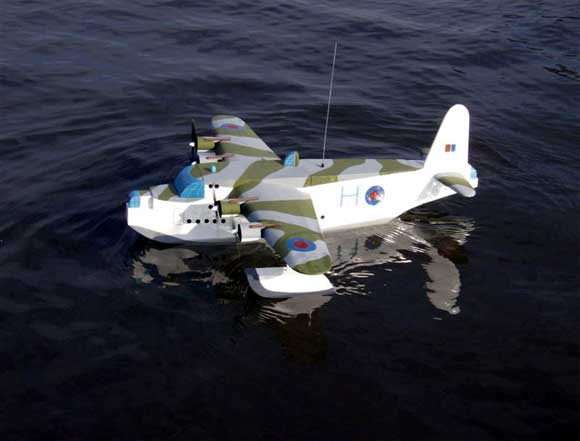
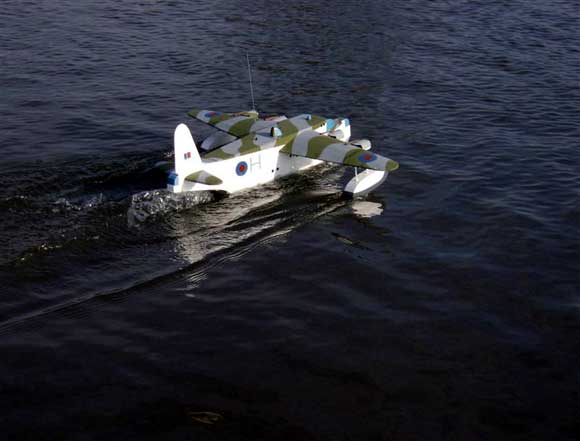
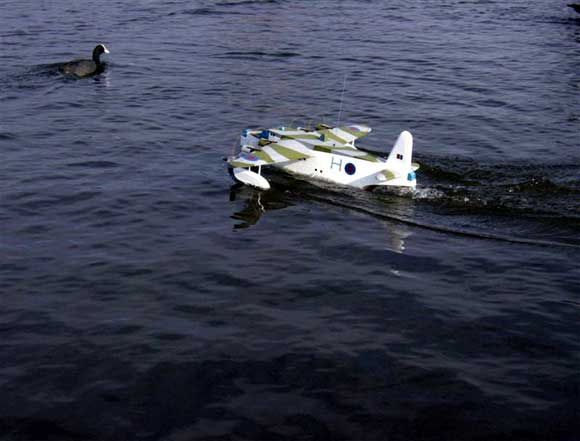
In the beginning
It being term time, I took our nine year old lad to the Imperial War Museum in London for a visit. In the shop, as small boys do, he spent all my money and among the items he (or was it me) purchased, was a small box containing some slot together, pre-cut cardboard aeroplanes. The aeroplanes were only about 3ins long, and consisted of a body, main wing and a tailplane, in thickish card. One of them was a Sunderland, and I looked at it and it was nicely finished with coloured printing on both sides in white with camouflage top surfaces. It struck me that ‘in the flat’ it had really caught the essence of a Sunderland and I wondered what a large model would look like with all flat surfaces and no curved bits. I guessed that it would be nice and straightforward to construct. This sort of project would just suit my ‘modus operandi’ for things different and easy to make.
The plan
A plan, and I use the term very loosely, was obtained by finding a three-view drawing of the flying boat on the internet and after some photocopier work, a full model size drawing was produced. Dimensions were chosen scientifically by holding out my hands and visualising how big I might like it to be. In this case it resulted in dimensions of: Length 620mm, fuselage width 90mm and a wingspan of 720mm. Consideration was also given to ensure there was sufficient space to locate the necessary battery (I was going to use a handy, but heavy 750g 6v 4.5Ah gel battery), receiver, and servo etc. I built a smallish card model to see if the proportions looked ok and to see how much I could reduce the wing size, as the wings didn’t need to be full-size, as the model was not intended to fly and would certainly get in the way of other models on the pond if I were not careful. The model was intended to be driven by a totally non-scale water propeller and steered by a conventional underwater rudder.
The method
Construction had to be very light and I decided to use 1.5mm ply for the main fuselage sides, and balsa for everything else, as thin as I thought I could get away with. For the hardware, Ebay furnished me with a Graupner Speed 400 unit consisting of a motor with reduction gears and propshaft for the main propulsion, which had the added bonus of being more compact than an in-line motor/coupling/shaft arrangement.
Build was fairly straightforward, as with almost no curved surfaces all the bits are simply shapes to be drawn and cut out. The main fuselage is nothing more than a simple box section. The rear tail and wings are flat of 6mm balsa sheet, with just some slimming and rounding off of the edges, and the steering control of Shorty being entirely by the water rudder. The gun turrets at the front, rear and on top, are of thin balsa sheet, as is the cockpit windscreen and in the spirit of flatness I did try to make the main wing as a flat box section, but it looked silly and as I couldn’t make the 30mm thick wings solid due to the weight, so unfortunately some proper hollow airfoil sections had to be attempted, but these still have a flat bottom. Obviously these would look better, and in the event of sufficient speed being generated, might even provide some unwanted lift – which would be a bit worrying!
Now, about the wings – some propellers would be needed, preferably three bladed, and even more preferably motorised to some degree, as I figured Shorty would look a bit naff zooming along with the propellers stationary or windmilling slowly. I applied some lateral thinking and found in Hobbies Catalogue some small electric motors and props as spares, which were intended for a lightweight r/c aeroplane. These props are 100mm in diameter and so a tad oversize and unfortunately two bladed, but they were incredibly cheap and meant to actually work on a model plane. They created an impressive draft on 6v, but more on that later and I thought they would be just the job and would contribute to the overall propulsion, but perhaps in hindsight I should have found suitable propellers before deciding how big to make the boat.
Enjoy more Model Boats Magazine reading in the monthly magazine.
Click here to subscribe & save.
The theory
One or more things were unknowable and had to wait until I had built the boat and had it sitting on the pond, it being a bit wide for the usual bath test. Would it be as fast as it needed to be, to look like a flying boat attempting to take off, or would the floats drag it round, or even dig in on one side and tip it over? The floats had been made slightly wider than the plan dimensions and set at a jaunty angle, to bump up their floatiness quotient and lessen the chance of digging in.
The practice
It was a nice day at the boating pond in Bushy Park in Surrey, with a small amount of breeze, but flat water. I put Shorty in the water and stepped back to admire it, looking good and very different in its Pacific paint scheme of white sides and camouflage top. Floating a bit low for comfort, but reasonably stable in the water with the wing floats working well. I applied some power – all the wing motors and the water motor were wired to the same speed controller so the props would speed up and slow down realistically in relation to the speed – and off we went. Sounded great, the four props giving that ‘beating’ sound of a true multi-engined aeroplane, but it lacked a bit of control, so obviously a larger rudder would be needed. This was definitely not to my satisfaction and when more power was applied, Shorty headed off with a marked nose-down attitude, which got worse as I applied more power to the mighty Bristol Pegasus radial engines, which oddly enough looked a bit like Scalextric motors. I reasoned this was due, either to excess weight or incorrect weight distribution and in an effort to lift the nose added a few bits of lead to the back end, which did make a very small improvement, but made it sit even lower in the water and was probably a bit counter productive.
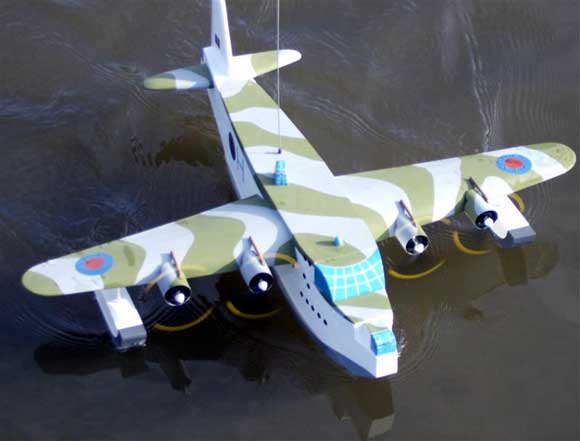
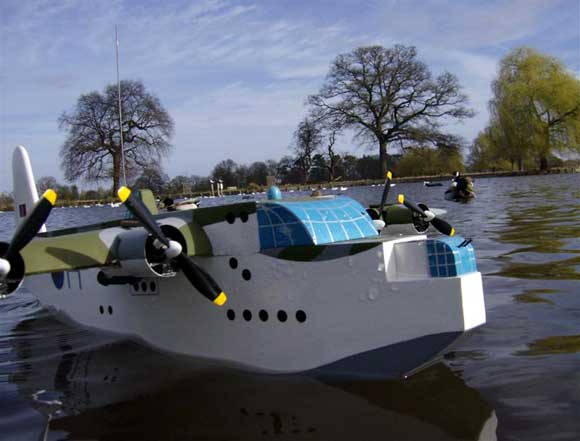
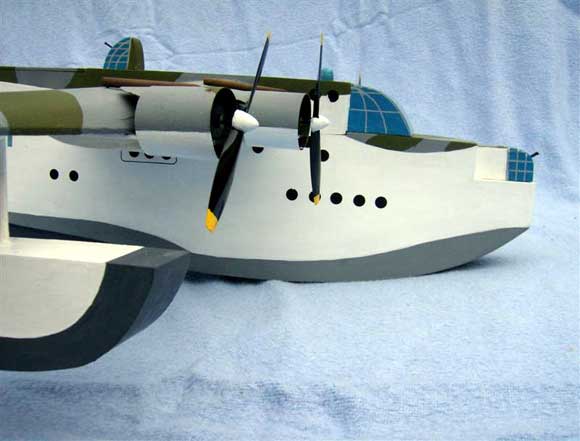
Not to be put off, I continued with the trial and tried each mode of propulsion separately. Perhaps the wing mounted props had the edge, but as I couldn’t go very fast anyway it was difficult to tell. Turning very gently, the outer props were dipping in the water chucking spray over all the place, a problem I thought would go away or at least lessen, once the overall weight has been sorted out.
The adjustments
Back in the hangar, or front room as it’s known, I pondered the problems. The 6v 7.2v 3.7Ah NiMh battery on order would only be 385gm, giving a very useful weight saving, but then I took a bold decision, based on the sterling performance of the tiny wing motors, to remove the water drive completely, saving another 230gm, and allowing me to move the battery rearwards in the hull. It rather tickled my fancy that as a model flying boat it would actually only be air propeller driven and not a half and half effort. Another rudder needed fabricating, but the main worry was the tendency of the nose to dive. Was it the hull shape, weight distribution, C of G, excess weight, or what? I made some larger wing floats, but they looked horribly large and decided I would use some temporary measures instead to see if they were required. I was also experiencing some loss of control at a distance and had to put an aerial on top of the fuselage as it might be that the motors with all the wiring in the wing were affecting the signal.
More practice
So to the pond again, this time with a brand spanking new compact 3700mAh battery, double superchargers on the mighty Bristol Pegasus radial engines (the new pack is 7.2v as against the previous 6v) and an oversize water rudder. What a difference this all made!
The boat sat much higher on the water and after a few gentle turns to check the stability, I applied some power and to my relief the nose lifted like I had hoped it would. I tried a gentle turn with half power, but as is it was a bit breezy the wing dipped right down on the leeward side. Well, I suppose a bit of a list never hurt anyone, however as one wing went down, the other came up and the wind got under it and was using it as a lever, I almost had a paddle boat for a few seconds. I was about to reach for the waders, but panic throttling back (controlled engine shutdown) let it drift and head approximately into wind, a bit like a weathercock as there is the big tail fin at one end, and as the nose came round so the wings levelled.
Keeping Shorty into the wind and applying power and all was well, a reasonable turn of speed, hull lifting, floats skipping on the surface and not showing any tendency to slew around. Props were well clear of the water now and only with full power turning did I get any dipping in of blades, although they did catch the odd wave now and then. I tried tapeing polystyrene to the floats and there did appear to be some improvement in the list situation, but they were creating a lot of splash due to the odd shape, so I removed them. Acceleration was quite remarkable – Shorty leapt forward on the faintest whiff of throttle. Those oversize props really do grab a big piece of sky and it also stops pronto with reverse thrust. Despite being a fair size, Shorty surprises everyone invited to feel its weight, which is a mere 850g, of which 385g is battery, so this obviously helps in the acceleration department. The oversize rudder was giving reasonable control, but only once a bit of way was on the boat. This was unavoidable, with no waterscrew or going to the expense of differential propeller control.
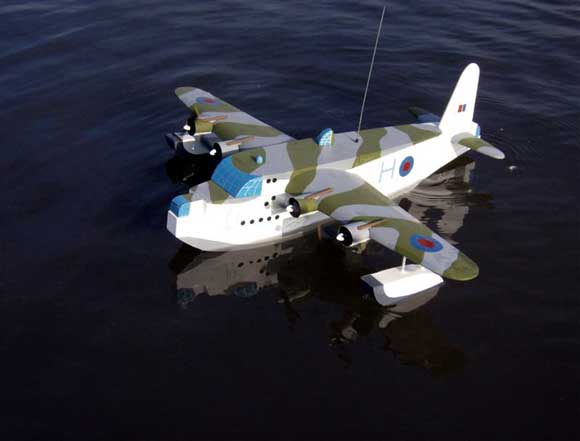
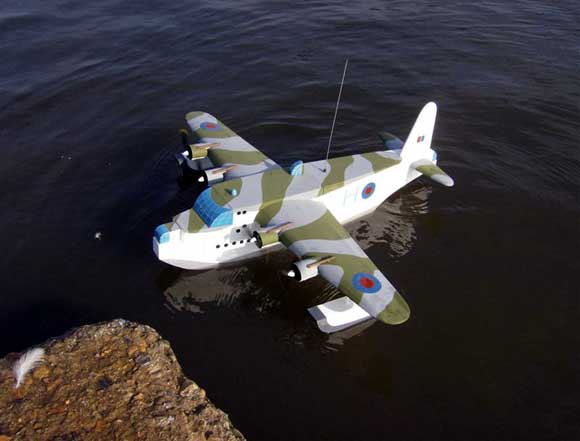
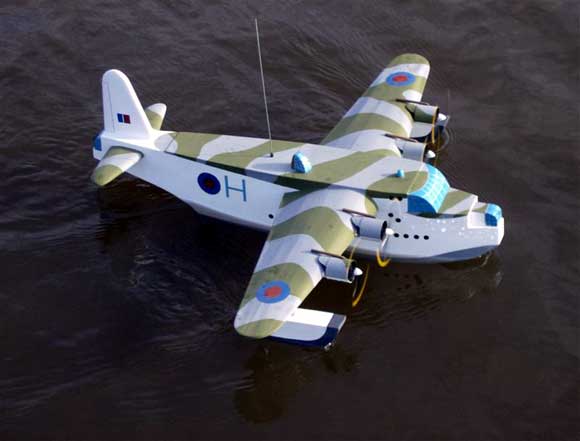
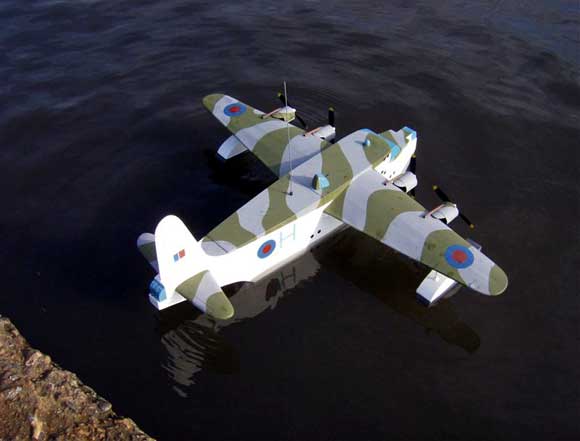
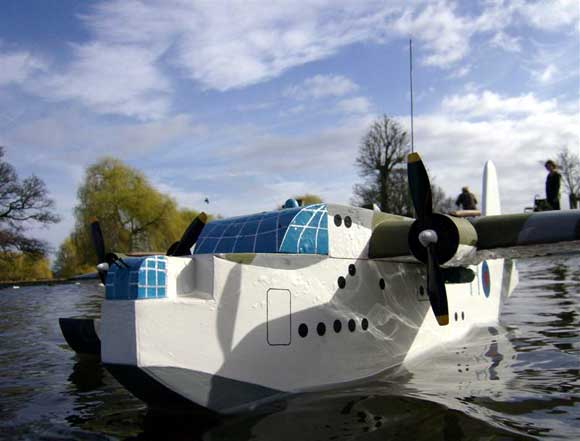
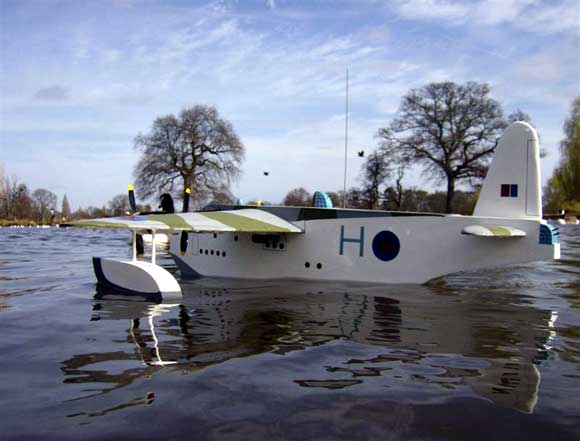
More theory and yet more practice
On a calm day I could see that Shorty would be great fun, but calm days are not always guaranteed and it would be a shame not to be able to play with Shorty just because of a bit of breeze. For really good stability on the water I was going to have to fit those oversize floats. With these fitted, and they are over twice the volume and hence floatiness of the old ones, there would be no dipping of wings and hopefully nothing to stop full power runs in any direction. Some decrease in drag might be gained by flattening off the fuselage underside; it currently had a shallow kink to simulate the step on the full-size craft, and some trim tabs at the rear might help. A further area of investigation are wing flaps, as almost the entire wing is washed over by the fairly substantial propeller draught. Any lift would do wonders for the attitude at speed and thus the performance, and more speed equals more lift. Wing flaps were indeed tried later, with predictably absolutely no positive effect whatsoever!
Further trials and ultimate success
The new floats, it has to be said, look far too big out of the water, but they do the business, and once on the water they look ok, as the original size float outline is in white and the extra bit is in very dark grey which goes unseen (if you squint a bit) against the murky depths. Shorty is now very stable with no leaning in a breeze and no dipping of props in the water unless they catch a wave. Speed, after all this mucking about? Well, much of a muchness viz small floats as far as I recall from the last test. One could say we have much more useable speed as full power can be applied at any time, even on turns, and in comparison to sundry other craft on the pond it is fairly satisfactory. The new large rudder was still not quite big enough and needed more throw, and so after a fourth modification the control is now really good. Having filled in the hull step with sheet balsa, to produce a more boat like bottom, Shorty now stays fairly level in the fore and aft direction. Speed? Well, to be honest I really want more, but with a project like this you are a bit in the dark at first and the next one will be faster. I still have a few more ideas for tweaking the performance, but where do you stop? Anyway, It certainly wowed then on the pond on its debut!
I’ll say it again, as a completely unbiased pondside observer that it looks great, sounds eerily realistic screaming along on full power and is most certainly different. Despite having a square fuselage, clipped wings, massive wing floats and generally a complete lack of any proper detail, the big white slab sides and camouflage top with the outline, look good on the water. To quote from an old beer advert: ‘It looks like a Sunderland, it sounds like a Sunderland and by golly, it is a Sunderland!’




